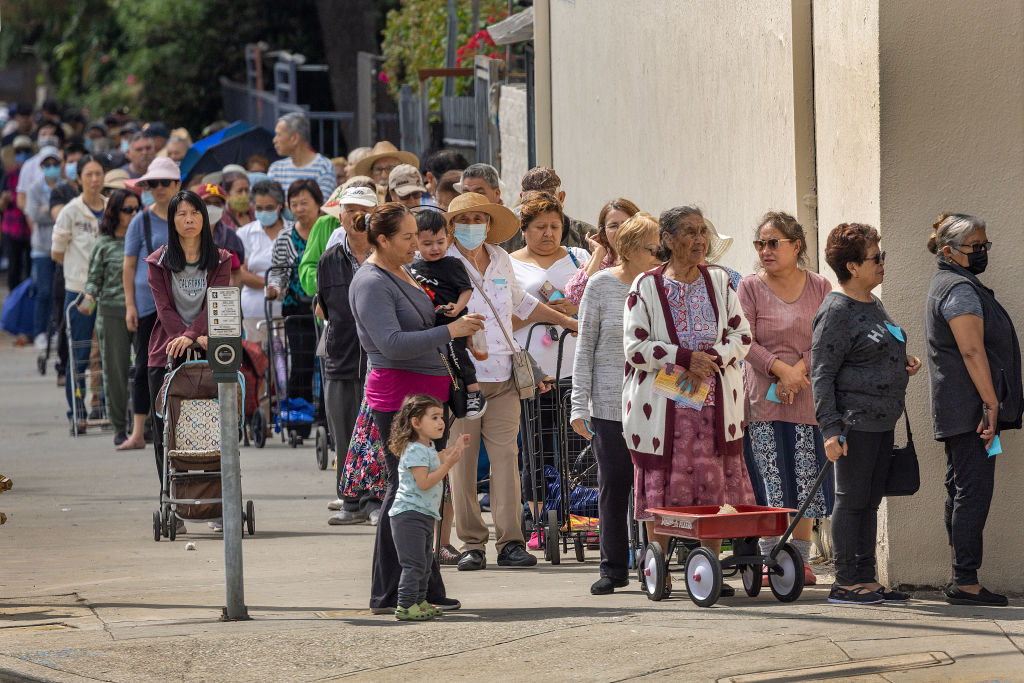
The U.S. poverty rate saw its largest one-year increase in history. 12.4% of Americans now live in poverty according to new 2022 data from the U.S. census, an increase from 7.4% in 2021. Child poverty also more than doubled last year to 12.4% from 5.2% the year before.
The U.S. poverty level is now $13,590 for individuals and $23,030 for a family of three. The new data shows that 37.9 million people lived in poverty in 2022.
America had previously experienced tremendous improvements in poverty reduction over the last two years. Safety net programs including expanded child tax credit lifted millions out of poverty and provided direct aid to low-income households. However, as programs like this were allowed to expire, the data shows that those programs were a short-lived lifeline. The Supplement Poverty Measure (SPM), which has now largely replaced the “official” poverty rate, calculates the poverty rate after accounting for many of the governments’ most important anti-poverty programs as well as differences in the cost of living.
The expiration of government support wasn’t the only reason poverty rose dramatically. Inflation and an overall increased cost of living created new financial challenges for families. SPM is based on the cost of essential items like food and housing, which rose sharply last year. In 2021, a family of four was considered poor if their income was $31,453. In 2022 though, that number increased nearly 10% to $34,518, capturing more households under this higher bar.
More From TIME
While low-income households struggled disproportionately, the average American household took hits as well. Median household income adjusted for inflation fell 2.3% last year to $74,580, The fastest rising inflation rate since 1981 dominated the gains of increased employment and rising wages.
California, Florida, and Mississippi are the three states with the highest percent of residents living in poverty. These represent an interesting mix of regions that economists don’t typically see together.
Much of California’s poverty occurs in Northern counties which are home to farming, mining, and manufacturing communities. High costs across the state have also led to higher poverty rates as often seen in San Francisco and Los Angeles, with 4.5 million living in poverty.
Florida’s higher poverty rates largely occur across the state’s panhandle. In Gadsden County, for example, one in four people live in poverty while two in five children do as well. Residents of Gadsden graduate high school at only half the rate as their peers in the rest of Florida. For decades, these low levels of educational attainment have plagued the region with high levels of unemployment and corresponding higher rates of poverty.
Poverty in Mississippi is not concentrated in one area but spreads far across the state. The regions with the highest poverty rates are concentrated around the Mississippi River, which are also the regions with the highest Black populations. Mississippi’s Black residents are three-times more likely to live in poverty than White residents, one of the worst ratios of any state in America. In Tunica County, right where the Mississippi river meets Tennessee, 68% of Black families live in poverty and 23.8% are unemployed according to a US Commission on Civil Rights, versus 12% of White families in poverty and 2% unemployed.
The highest increases in poverty occurred in the South, where research has shown the Child Tax Credit had the greatest effect in helping low-income families get the support they needed.
The White House was quick to jump in after the Census data release, blaming the rise in child poverty on congressional Republicans. President Biden derided “Republicans’ refusal to extend the enhanced Child Tax Credit” and went further to say that “The rise reported today in child poverty is no accident.” Economists found that child poverty would have been nearly 50% lower in 2022 if the expanded Child Tax Credit had remained in place.
Researchers at American Inequality have also found that the Earned Income Tax Credit (EITC) has had a profound impact in poverty reduction. The number of children living below the poverty line would have been 25% higher without the EITC and the program also decreased poverty severity for another 17 million people. President Biden’s 2024 budget proposed expanding this tax credit, though Republicans remain opposed.
Current poverty rates though are still below historic levels, and look most similar to rates seen in 2019. While financial hardship has decreased for Black and Hispanic Americans, poverty rates have now returned to pre-pandemic levels. A tremendous influx of funds to low-income households during the pandemic actually improved poverty in America.
For Americans over 65, support has not arrived. The poverty rate rose to 14.1% for these older Americans, reaching levels not seen since 2016. This happened despite the 8.7% cost-of-living adjustment in social security payments, largely because labor force participation among older people has remained low as pandemic job losses have made it harder for this group to re-enter the workforce.
Poverty in America reflects the inequality that plagues U.S. households. While certain regions have endured this pain much more than others, this new rising trend may spell ongoing challenges for even more communities. The federal support over the last 3 years showed just how much progress communities can make to reduce poverty, but the data now reveals what happens when those resources dry up.
More Must-Reads from TIME
- Inside Elon Musk’s War on Washington
- Meet the 2025 Women of the Year
- The Harsh Truth About Disability Inclusion
- Why Do More Young Adults Have Cancer?
- Colman Domingo Leads With Radical Love
- How to Get Better at Doing Things Alone
- Cecily Strong on Goober the Clown
- Column: The Rise of America’s Broligarchy
Contact us at letters@time.com